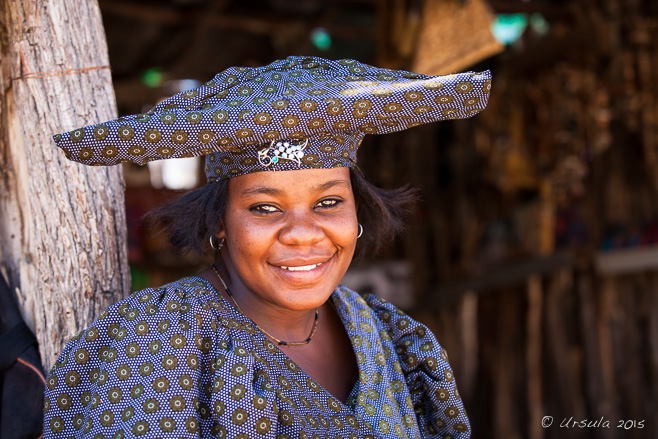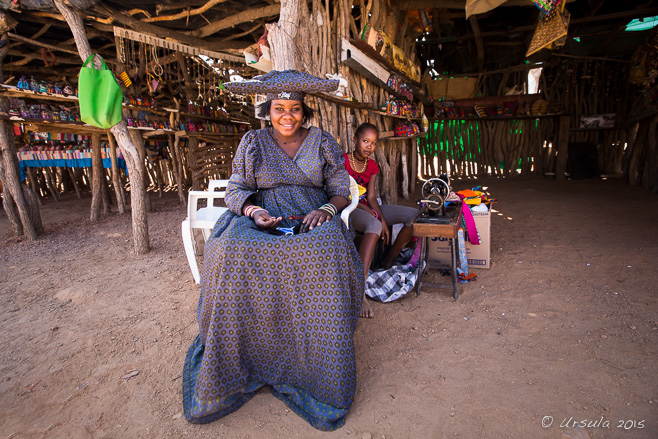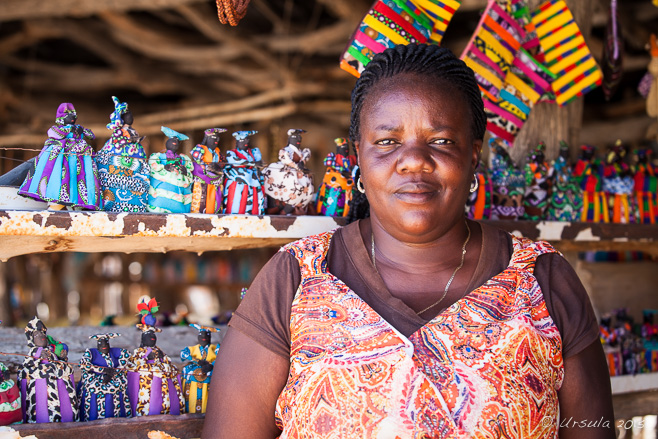
Herero Woman in Blue
According to Google Maps, it takes 4 hours and 42 minutes to drive the 309 kilometres through the heart of Stro gateway to Namibia’s northern border regions.
Google Maps doesn’t tell you that most of this distance is on what “Maps of Namibia” calls “Main-Gravel Roads”: dusty, corrugated, white-gravel, roads with potholes that leap out without notice and where on-coming or overtaking vehicles envelope you in blinding clouds of opaque dust.
I can’t even begin to imagine what these roads are like in summer! It was August – mid-winter – when we (photographer Ben McRae, Pedro Ferrão Patrício from Photoburst, Namibian guide Morne Griffiths, myself, and four other photography enthusiasts) traversed them. Even so, it was well over 30°C outside by mid-morning, and much hotter inside the truck. Mirages danced on the roads ahead as the heat pulsated all around. The wind from open truck-windows let in the dust and sucked all the moisture out of one’s body.
As they say, “It’s a dry heat.”
We passed miles apon miles of dry, rolling veld, covered in rocks and dry grass punctuated by thorn trees. Dust devils raced across the horizon and boys in donkey carts trotted along the verges. There were horses, goats, and herds of fat cattle; clearly the sere desert grasses provide more nutrients than you would think from looking at them. The odd homestead sat well back from the dusty roadside.
We were warned: in the towns, there were to be strictly no photos taken out of the truck windows. If we took pictures without prior negotiation, the tour company could be charged an exorbitant fee. So, the houses and shops and markets we passed went by unrecorded. I felt like I was watching the cast of characters from the “The No. 1 Ladies’ Detective Agency”: professionally dressed women with elaborately braided hair and over-sized glasses teetering across uneven sidewalks in their colourful high heels; “traditionally built” women in head cloths and wildly patterned dresses sashaying through the streets; men in dark suits and shiny, pointy shoes gathering on corners; men, woman and children in bangles and beads all jostling at shop fronts.
When we stopped for supplies in one of the towns, we were warned again: don’t buy anything from the Vambo (Aawambo or Ambo) people who were bound to crowd around us begging or trying to sell gems or bangles; if we engaged with them we’d never escape.
A simple trip to the supermarket was like walking into another world: shoppers in all manner of tribal dress – including Himba woman wearing only ochre paint and leather skirts – were gathering their groceries amid aisles of products I didn’t recognise. Although the uniformed shop-workers spoke English, Afrikaans and tribal languages flowed all around like a river of Babel.
After what seemed like hours of sensory over-load, it was a relief to stop at the more relaxed roadside souvenir-stands run by Herero women. The Herero have a reputation as skilled seamstresses, and the stalls they run contain colourful patchwork cloth products. Many of the women still dress in a distinctively African adaptation of the Victorian costume foisted upon them by German missionaries in the early 20th century: a voluminous floor-length dress that might comprise up to seven layers of cloth. The unique head-dress represents the horns of a cow, a particular status symbol in a culture where your wealth is measured by how many cows you own.
I admired the handiwork, made a few small purchases, and paid a small fee – well worth it to spend time making pictures and chatting with these lovely women.

Herero Woman in Blue
Up until the end of the 19th century, Herero people dressed in traditional tribal fashion. However, during the days of German colonial rule, missionaries introduced Victorian style dress because they didn’t liked Herero women to be naked. Herero men started wearing German uniforms they took from soldiers killed during the conflict in the early 20th century, and may still wear uniforms on special occasions. From the time they are married, women were expected to make their own multi-layered dresses.

Woman with Herero Dolls
Today, some women chose more “modern” Western dress.

Girl with Doll
I loved how this girl’s balding doll has her hair so neatly braided.

Herero Dolls
Herero dolls are painstaking handmade, with wire arms and hands and painted faces.

Herero Sisters
Sisters in casual dress, were keen to be photographed: I could only oblige.

Smiling Woman in an Orange Headdress

Herero Woman in Brown
This articulate young woman has just finished her Namibian tourism certificate, and hopes to become an official guide.

Young Girl in Black
Without any coaching, young girls, like this 13 year old, demonstrate an effortless grace.

Young Herero with Patchwork

Herero Family
The women’s elaborated clothes, and the crafts they sell, are carefully sewn using old manual Singer sewing machines and finished by hand.

Waterhole
Our next stop, an hour and a half later, was at a small waterhole in the hot, dusty hills. Cattle have come in for a rest and a drink.

African Golden Weaver
The thorn trees near the roadside are full of chattering finch and weavers.

Goats in the Dust
A man guides a herd of goats though the heat of the afternoon.
We still had miles of hot, bumpy road to travel before we reached our stop for the night.
I had my Herero doll and fond memories of conversations with some interesting and engaging women who have found a way of making their traditions support their futures.
 I hope they can continue to make their own way…
I hope they can continue to make their own way…
To the future!
Pictures: 14August2015


















.png)

